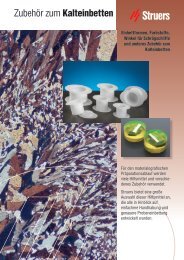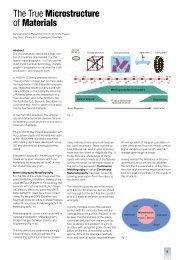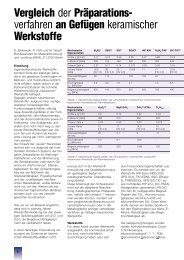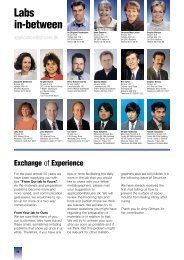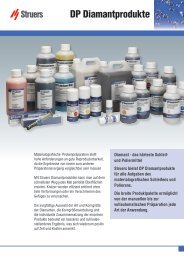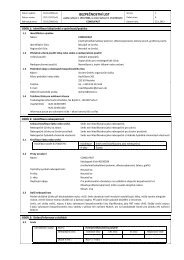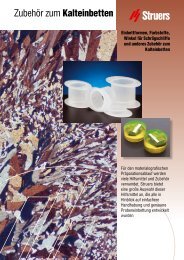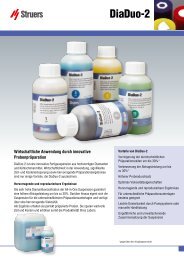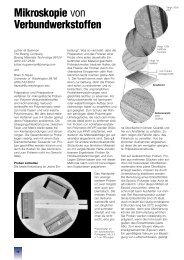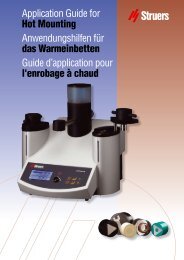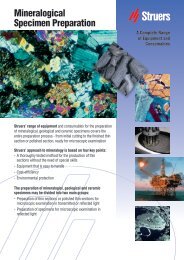Download Structure news # 13 (PDF 2.23 MB) - Struers
Download Structure news # 13 (PDF 2.23 MB) - Struers
Download Structure news # 13 (PDF 2.23 MB) - Struers
Create successful ePaper yourself
Turn your PDF publications into a flip-book with our unique Google optimized e-Paper software.
<strong>Structure</strong><br />
<strong>news</strong><br />
1<br />
<strong>Structure</strong> <strong>news</strong> · # <strong>13</strong> · June 2012<br />
www.struers.com<br />
Diamond products from <strong>Struers</strong><br />
In this issue<br />
New cut-off machine 2<br />
Diamond products 3-4<br />
Application case 5-14<br />
<strong>Structure</strong> <strong>news</strong><br />
<strong>Struers</strong> Diamond Products are the fastest way to obtain a perfect<br />
surface every time. They efficiently remove scratches caused by<br />
grinding without causing excessive deformation to or smearing of<br />
the microstructure.<br />
The careful selection of diamond type, grading of grain size and<br />
formulation of the individual products means you will have superior,<br />
satisfactory results which again means improved cost and<br />
time efficiency.<br />
is a quarterly <strong>news</strong>letter from<br />
<strong>Struers</strong>, the world leader in<br />
materialography. The <strong>news</strong>letter<br />
provides you with up-to-date<br />
information on materialography,<br />
applications and new innovative<br />
products. For more information<br />
about our products, please<br />
contact your local sales<br />
representative, listed on<br />
www.struers.com/distributors<br />
To subscribe to <strong>Structure</strong> <strong>news</strong>,<br />
please go to our website;<br />
www.struers.com/structure<strong>news</strong><br />
Read about the improvements on<br />
<strong>Struers</strong> DiaPro Suspension and<br />
DP-Spray on pages 3-4.
<strong>Structure</strong><br />
<strong>news</strong><br />
New products · # <strong>13</strong> · June 2012<br />
2<br />
New products<br />
<strong>Struers</strong> covers the entire range of equipment and consumables for materialographic specimen preparation - from<br />
uncomplicated manual machines to sophisticated computerized preparation solutions. <strong>Struers</strong> is constantly working on<br />
improving existing products and developing new ones.<br />
New manual cut-off machine<br />
We are pleased to introduce a new manual cut-off machine for 250 mm cut-off wheels, Labotom-5. In addition to its extremely<br />
user-friendly and simple control panel with only three buttons: Start, Stop and Flushing cleaning water, Labotom-5 has the following<br />
features:<br />
Safety lock and emergency stop<br />
for optimal protection of the user.<br />
The motor has an electrical brake to<br />
ensure that it stops before the safety<br />
lock is released.<br />
Strong light over the cutting<br />
table keeps the cutting<br />
process area well illuminated.<br />
Large cutting table (316<br />
mm / 12.4” wide and<br />
225 mm / 8.9” deep)<br />
for easy clamping of the<br />
workpieces. The cutting<br />
table has five 10 mm<br />
T-slots; three on the lefthand<br />
side and two on<br />
the right-hand side.<br />
Ergonomic cutting<br />
handle, designed to<br />
let the operator easily<br />
cut even very hard and<br />
difficult materials.<br />
Steep slope in the cutting chamber to ensure that<br />
the cooling water runs off and does not accumulate<br />
inside the cutting chamber.<br />
Cleaning gun with strong water<br />
flow for easy maintenance.<br />
Read more about Labotom-5 at www.labotom.com
<strong>Structure</strong><br />
<strong>news</strong><br />
New products · # <strong>13</strong> · June 2012<br />
3<br />
Improved DiaPro suspensions<br />
DiaPro is a unique line of diamond suspensions, specially<br />
developed for extra-high performance with <strong>Struers</strong><br />
grinding and polishing surfaces, which improves your efficiency<br />
significantly. Each DiaPro suspension has been developed and<br />
optimised for a specific surface, and the results are<br />
outstanding. Preparation times are reduced by 30% on average.<br />
At the same time, DiaPro delivers outstanding planeness, edge<br />
retention and reproducibility.<br />
The DiaPro Allegro/Largo, DiaPro Dac and DiaPro Nap B<br />
suspensionhas now been improved. This means:<br />
• High removal rate<br />
• Low constant viscosity<br />
• Easy cleaning<br />
We care about the environment!<br />
<strong>Struers</strong> continuously strive to make<br />
our products as environmental friendly<br />
as possible and is a ISO 14001 certified<br />
company. We have recently evaluated<br />
all <strong>Struers</strong> consumables with focus on<br />
the development (composition of raw materials and design),<br />
production, use and disposal. We are pleased to share this<br />
evaluation with you and have marked our most environmentalfriendly<br />
consumables with our globe & leaf symbol in <strong>Struers</strong>’<br />
Consumables guide 2012.<br />
It will give you the opportunity to choose not only according to<br />
specifications but also according to the relative environmental<br />
impact of our products. See the Consumables guide at<br />
www.struers.com/consumablesguide<br />
DiaPro suspensions are developed to give the best preparation<br />
results in the shortest time possible. Consequently, the removal<br />
rate is very high which again implies a lot of grinding/polishing<br />
dirt. The new DiaPro contains a special component which helps<br />
the dirt flow more freely, making it easier to remove it from the<br />
specimens, the surfaces and the machine. This effect is most<br />
visible when using DiaPro Allegro/Largo as the amount of dirt<br />
is larger on these surfaces. See pictures on next page.<br />
Improved DiaPro
<strong>Structure</strong><br />
<strong>news</strong><br />
New products · # <strong>13</strong> · June 2012<br />
4<br />
DP-Spray with nitrogen as propellant<br />
With its quickly evaporating carrier, allowing the diamonds to<br />
provide an aggressive cutting action and a fast material<br />
removal, DP-Spray (Diamond Polishing) is a very good<br />
solution.<br />
To live up to <strong>Struers</strong>’ ISO 14001 certification, we constantly<br />
strive to optimise our products and make them as<br />
environmentally friendly as possible. We have therefore<br />
changed the propellant in the DP-Sprays to nitrogen. Nitrogen<br />
is produced from atmospheric air and when used and sprayed<br />
into the air it has no impact on the environment.<br />
MD-Largo after flushing with water: left DiaPro, right new DiaPro.<br />
The new DP-Spray contains the same quantity of diamonds as<br />
the former type and will last for the same number of<br />
preparations. The diamond squirt is wider, which gives a<br />
better distribution of the diamonds onto the grinding/polishing<br />
surface.<br />
DP- Spray<br />
MD-Allegro after flushing with water: left DiaPro, right new DiaPro.<br />
DiaPro vs. new DiaPro.
<strong>Structure</strong><br />
<strong>news</strong><br />
Application · # <strong>13</strong> · June 2012<br />
5<br />
Application<br />
Materialographic preparation of a ballpoint pen for EBSD/EDS characterization<br />
Authors: H. S. Ubhi & K. Larsen, Oxford Instruments, United Kingdom, P. Nowakowski, Oxford Instruments, France, A. Guesnier,<br />
<strong>Struers</strong> A/S, Denmark.<br />
Introduction<br />
Electron Backscatter Diffraction (EBSD) is a scanning electron<br />
microscope (SEM) based technique that is finding increasing<br />
application in the field of materials microstructural characterization.<br />
EBSD is a surface-sensitive technique, where diffracted<br />
electrons escape from within only a few tens of nanometers of<br />
the specimen surface to produce electron<br />
back-scattered diffraction patterns.<br />
Residual surface deformation or reaction<br />
product layers from specimen preparation<br />
can therefore be detrimental for<br />
EBSD pattern generation. Specimen<br />
preparation is hence very critical for<br />
successful EBSD characterization of<br />
materials. A preparation method suitable<br />
for EBSD is also suitable for the<br />
less demanding Energy-dispersive X-ray<br />
spectroscopy (EDS or EDX) analytical<br />
technique used for the elemental<br />
Fig. 1. Tip of a ballpoint pen chemical characterization of a specimen.<br />
A ballpoint pen is a writing instrument with an internal ink<br />
reservoir and a sphere for a point, see fig. 1.. It is a product of<br />
experimentation, chemistry and precision manufacturing. The<br />
Table 1<br />
materialographic preparation of such a pen is discussed as well<br />
as the results gained using both optical microscope and SEM<br />
together with EBSD and EDS techniques.<br />
Preparation process<br />
A ballpoint pen is mounted in bakelite with conductive carbon<br />
filler, called PolyFast, specially developed for SEM examination.<br />
The specimen is ground on coarse SiC Foil # 320 until just<br />
underneath the middle point through the thickness of the<br />
section to make sure that the sphere does not fall out during<br />
grinding and polishing.<br />
It is expected that the specimen contains two components: a<br />
steel ball and a brass reservoir. The preparation process used,<br />
see Table 1, is developed taking into consideration that the<br />
physical properties of both materials are different. A rigid disc,<br />
MD-Largo is used for Fine Grinding and a low resilience polishing<br />
cloth is used for diamond polishing to ensure optimum edge<br />
retention of both components, the hard steel ballpoint and the<br />
soft reservoir made of brass. For final polishing an oxide<br />
polishing mixture consisting of 96 ml colloidal silica (OP-S)<br />
mixed with 2 ml H 2<br />
O 2<br />
(30%) and 2 ml NH 3<br />
(25%) is used in<br />
order to obtain a scratch-free result on the brass reservoir.<br />
The preparation<br />
method is run on a<br />
Tegramin-30. The<br />
specified forces<br />
are either for one<br />
specimen of 30 mm<br />
in diameter when<br />
running a single<br />
specimen, or for 6<br />
specimens 30 mm<br />
in diameter<br />
clamped in a<br />
specimen holder.
<strong>Structure</strong><br />
<strong>news</strong><br />
Application · # <strong>13</strong> · June 2012<br />
6<br />
Scanning electron microscope and optical microscope overview of a ball pen<br />
SEM image of the tip of a ballpoint pen.<br />
Ink reservoir<br />
The channel between the ballpoint<br />
and the reservoir is partially revealed,<br />
any deeper grinding and polishing to<br />
show the whole channel would result<br />
in the point ball falling out.<br />
SEM Montage of a ball pen<br />
Sphere for a point<br />
Optical image showing how the ballpoint fits in the brass reservoir.<br />
Bright Field, X 100.<br />
Optical image showing the microstructure of the ballpoint. DIC, X 1000.
<strong>Structure</strong><br />
<strong>news</strong><br />
Application · # <strong>13</strong> · June 2012<br />
7<br />
Analytical equipment<br />
The specimen is examined both optically and in the SEM, and characterized using EBSD/EDS techniques employing the Oxford<br />
Instruments NordlysNano EBSD, X-Max® 80 mm 2 EDS detectors and Oxford Instruments AZtecHKL EBSD Software. EBSD data is<br />
acquired using 8x8 binning and SEM settings with 8 kV acceleration voltage and 3.4 nA probe current. EDS quant is acquired with<br />
20 and 8 kV.<br />
Reservoir characterization<br />
EDS results: Reservoir<br />
SEM BEI (backscattered<br />
electron image) image of<br />
reservoir at zero tilt showing<br />
cold worked structure with<br />
bright elongated particles.<br />
EDS spectrum and quant 20<br />
kV zero tilt, shows the base<br />
alloy to be 60/40 Cu Zn alloy<br />
with addition of lead.<br />
EDS spectrum from the<br />
bright lead particles. The<br />
lead is added to enhance<br />
the machining of the brass.<br />
Wt % Cu Zn Pb Total<br />
reservoir 59.26 38.37 2.37 100.00
<strong>Structure</strong><br />
<strong>news</strong><br />
Application · # <strong>13</strong> · June 2012<br />
8<br />
Phase identification: Reservoir<br />
The phase diagram of Cu Zn shows that in the 60/40 composition<br />
the alloy has two phases, alpha and beta. 8 kV 3.4 nA EBSD<br />
patterns from the brass reservoir confirm presence of the two<br />
phases.<br />
EDS Layered Image 3. M_series<br />
EBSD pattern: Fcc/alpha Cu rich<br />
EBDS phase map.<br />
EBSD pattern: Bcc/beta Zn Rich<br />
At % Cu Zn Total<br />
beta 57.98 42.02 100.00<br />
alpha 65.33 34.67 100.00<br />
Note: IPF map shows that the beta phase is mainly green,<br />
and the alpha phase red and blue indicating a strong<br />
texture, grain size determination is a challenge.<br />
IPF Colouring<br />
Copper<br />
ZO 111<br />
SEM: 8kV 3.4nA<br />
% alpha = 81<br />
% beta = 18<br />
% lead =1<br />
001 101
<strong>Structure</strong><br />
<strong>news</strong><br />
Application · # <strong>13</strong> · June 2012<br />
9<br />
EDS Maps: Reservoir<br />
Zn L_series<br />
Cu L_series<br />
Pb M_series<br />
EDS Layered Image 3 M_series
<strong>Structure</strong><br />
<strong>news</strong><br />
Application · # <strong>13</strong> · June 2012<br />
10<br />
EBSD texture: Reservoir<br />
alpha Cu rich<br />
beta Zn Rich<br />
Results and discussion for the reservoir<br />
The reservoir is based on a two phase 60/:40 CuZn brass alloy with 2% Pb for free machining properties.<br />
The microstructure comprises two phases: alpha and beta, with a dispersion of Pb particles. The Pb particles did not produce any<br />
EBSD patterns. Low magnification EBSD maps show: band contrast, phase distribution and orientation maps with corresponding<br />
EDS maps. The shown pole figures indicate a cold worked texture with partial fibre texture in alpha and in beta.
<strong>Structure</strong><br />
<strong>news</strong><br />
Application · # <strong>13</strong> · June 2012<br />
11<br />
Ballpoint characterization<br />
SEM BEI image zero tilt tempered martensite, some porosity (grey contrasting particles).<br />
EDS: Ballpoint<br />
EDS quant 20kV zero tilt indicates a <strong>13</strong> wt% chromium steel.<br />
Wt % Si Cr Mn Fe Total<br />
ball 0.40 12.93 1.03 85.64 100.00
<strong>Structure</strong><br />
<strong>news</strong><br />
Application · # <strong>13</strong> · June 2012<br />
12<br />
Phase identification: Ballpoint<br />
Search for steels in the composition range shows a match with X65Cr<strong>13</strong> bearing steel. Calculated 14% Cr isopleth indicates the<br />
structure to be ferrite with M 23<br />
C 6<br />
in the 0.6-0.8 range. 1x1 EBSD patterns at 8kV from the matrix and particles respectively,<br />
confirms ferrite and M 23<br />
C 6<br />
particles. Phases used for mapping Fe bcc and Cr15.58Fe7.42C6.<br />
EBSD pattern: matrix.<br />
EDS quant 20kV zero tilt of ball carbide.<br />
EBSD pattern: Carbides – M 23<br />
C 6<br />
.<br />
EDS quant 20kV zero tilt of ball matrix.
<strong>Structure</strong><br />
<strong>news</strong><br />
Application · # <strong>13</strong> · June 2012<br />
<strong>13</strong><br />
EBSD Maps: Ballpoint<br />
EDS Maps: Ballpoint<br />
EBSD pattern quality map.<br />
Fe Lα1_2<br />
EBDS phase map.<br />
Cr Lα1_2<br />
IPF map.<br />
C Kα1_2
<strong>Structure</strong><br />
<strong>news</strong><br />
Application · # <strong>13</strong> · June 2012<br />
14<br />
Result and discussion for the ballpoint<br />
The steel ball is a chromium rich alloy, with a tempered<br />
martensitic structure and fine M 23<br />
C 6<br />
particles.<br />
Conclusion<br />
The ballpoint pen examined is found to contain two<br />
components, a reservoir made of free machining brass having<br />
good corrosion properties and a ball point made of steel with<br />
hard wearing and corrosion properties.<br />
Courses and Events<br />
Keep yourself updated on upcoming<br />
materialographic courses and events<br />
on www.struers.com/events<br />
Effectiveness of modern materialography, optical and SEM<br />
microscopy, EDS and EBSD techniques give possibility of deep<br />
insight into materials, structure, properties and processing.<br />
New office and lab in China<br />
<strong>Struers</strong> in China have moved to a new facilities. Since March, they are located in a brand new office and lab at Zhang Jiang<br />
Hi-Tech Park in Shanghai.<br />
Copyright © 2012 <strong>Struers</strong> A/S.<br />
All Rights Reserved.



